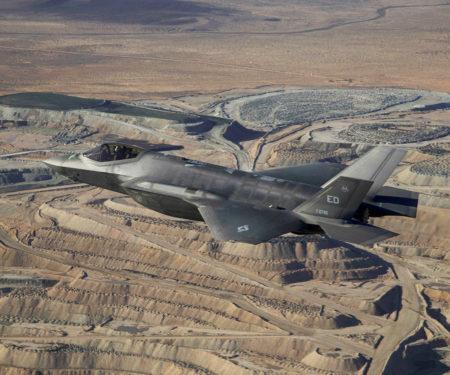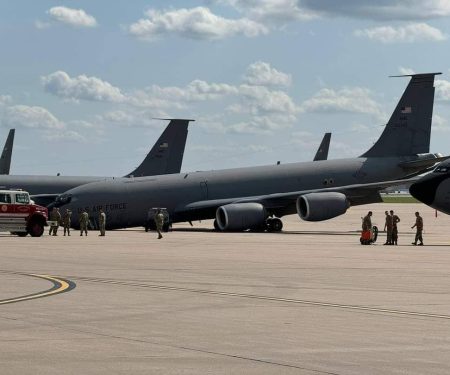Is a Cyber Force Next? Lawmakers Want Independent Study
Even After F-35’s TR-3 Software is Approved, Frequent Patches May Be Needed
Air Force Investigating After KC-135 Landing Gear Retracts While Parked
Radar Sweep
Biden Secretly Gave Ukraine Permission to Strike Inside Russia with US Weapons
The Biden administration has quietly given Ukraine permission to strike inside Russia—solely near the area of Kharkiv—using U.S.-provided weapons, two U.S. officials and two other people familiar with the move said May 30, a major reversal that will help Ukraine to better defend its second-largest city.
Unprotected: Troops Spent Decades Elbow-Deep in Dangerous Chemicals to Keep Nuclear Missiles Working
It's the radiation that most people think about. Shut in 60 feet underground not far from the massive nuclear weapons, missileers keep careful watch of the projectiles designed to bring about Armageddon, doing small repairs and staying alert for long, sunless hours of duty. But when more significant maintenance needs to be done, when something bigger breaks, support personnel such as Kimberly Cross are brought in at a moment's notice and for hours at a time to keep the missiles working. For those maintainers, it's the long list of hazardous substances and chemicals, sometimes oozing from equipment, that is the real risk.
Enclosures to Defend F-15Es From Drone Attacks Eyed at Seymour Johnson AFB
Officials at Seymour Johnson Air Force Base in North Carolina are looking into the possibility of setting up physical barriers to help protect F-15E Strike Eagles there from being attacked by small drones. The anti-drone barricade idea underscores the danger that drones present right now to U.S. military facilities and critical civil infrastructure domestically, as well as to American forces overseas.
Behind the Scenes of the Pentagon’s Race to Aid in Taiwan’s Defense
Last fall, during a House Armed Services Committee hearing, the Pentagon came with a message: Help us help Taiwan. The year before, Congress had for the first time allowed the Defense Department to ship its own stocks to the island nation—up to $1 billion each year. But lawmakers didn’t offer funding to replace those stocks. To some in the Pentagon, it was like being asked to donate to a food bank without a grocery budget.
How America Inadvertently Created an ‘Axis of Evasion’ Led by China
Western sanctions and export controls were meant to subdue America’s enemies, leveraging the power of the dollar to strong-arm governments into submission without the bloodshed of military force. They have inadvertently birthed a global shadow economy tying together democracy’s chief foes, with Washington’s primary adversary, China, at the center.
US Military Defends Africa Strategy in Light of Coups and a Drift Toward Russia
The head of the U.S. military in Africa vigorously defended the country’s counterterrorism strategy on the continent and vowed to press forward with it despite a wave of criticism and a drift among African nations toward seeking security help from Russia instead. In an interview with The Associated Press on May 29 at Africa Lion, a war games exercise in Morocco, Gen. Michael Langley blamed a tide of Russian disinformation for anti-U.S. sentiment in volatile regions.
OPINION: The National Guard Is Essential to America’s Indo-Pacific Strategy
Gen. Daniel R. Hokanson serves as the 29th chief of the National Guard Bureau and is a member of the Joint Chiefs of Staff. In the following op-ed, he discusses what the Guard has been doing with partners and allies this year in the Indo-Pacific, as the U.S. seeks to blunt Chinese influence in the region.
Pentagon Bets $480m on AI-Fueled Intel Platform
The Pentagon wants to expand its experimental intelligence platform across the combatant commands, to the tune of $480 million over the next five years. ... The Maven Smart System prototype has been part of the Pentagon’s global information dominance experiments to provide more seamless communications, also called combined joint all domain command and control, CJADC2.
AI Startup Wallaroo Tapped to Help Space Force Operationalize Machine Learning
Wallaroo.AI, a company that helps businesses deploy machine learning models, is setting its sights on the military market. The New York-based startup has been selected to participate in the U.S. Space Force’s TAP (Tools, Applications & Processing) Lab accelerator program in Colorado Springs. The accelerator is focused on the use of commercial technologies for space domain awareness, a capability sought by the U.S. military as threats in the space domain heighten.
Sentinel SLP-A Finds FY25 New-Start Backing in Draft Legislation
The Air Force has secured backing in draft legislation for new-start procurement authorization in fiscal year 2025 of the Secondary Launch Platform-Airborne (SLP-A) for the Sentinel intercontinental ballistic missile program, even as the Pentagon works to revise the program in the wake of cost growth that triggered a statutory acquisition review.
North Korean Missile Debris Found in Ukraine: Defense Intelligence Report
Remnants of ballistic missiles produced in North Korea have been found throughout Ukraine, further confirming U.S. accusations that Pyongyang is arming Russia’s war effort, according to a new unclassified report released May 29 by the Defense Intelligence Agency (DIA).
VIDEO: What Happened to the Luftwaffe? Aerial Warfare on D-Day
The Allies knew that the Normandy landings would be an era defining moment. Succeed and victory in the war was surely theirs. Fail, and the consequences could be catastrophic. Thus, well before D-Day took place, the Allies planned to use their airpower to the set the stage for the landings. ... Curator Hattie Hearn looks at the aerial battle for Normandy. How did the Allies win air superiority? Where was the German response to D-Day? And how did Allied air power affect the fighting on the ground?




